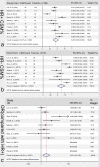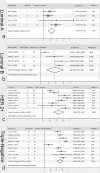Meta-Analysis of Shrinkage Mode After Neoadjuvant Chemotherapy for Breast Cancers: Association With Hormonal Receptor
- PMID: 35444932
- PMCID: PMC9014257
- DOI: 10.3389/fonc.2021.617167
Meta-Analysis of Shrinkage Mode After Neoadjuvant Chemotherapy for Breast Cancers: Association With Hormonal Receptor
Abstract
Background: Patients with concentric shrinkage mode after neoadjuvant chemotherapy (NAC) is considered to be ideal candidates for breast conserving treatment (BCT). While, what proportion of patients would represent CSM have not been well defined. This study was conducted to pool the rates of concentric shrinkage mode (CSM) in patients undergoing NAC, determine the impact of hormonal receptor on the shrinkage mode after NAC and estimate the rates of the CSM in various subgroups.
Methods: We conducted a systematic review following the guidelines for Meta-Analyses and Systematic reviews for the PRISMA guidelines. We systematically searched the literature about shrinkage mode after NAC from PubMed, Web of Science, Embase, The Cochrane Library, CNKI, Wanfang database published from January 2002 to June 2020 on breast cancer shrinkage mode after NAC and carefully screened the literature by using eligibility criteria: (1) patients with primary breast cancer treated with NAC; (2) publications with available data of shrinkage mode measured by magnetic resonance imaging (MRI), or data of pathology and hormonal receptor. The association between shrinkage mode and hormonal receptor was estimated using Stata 15.1 software.
Results: This analysis included a total of 2434 tumors from 23 papers. The included studies were heterogeneous (I2 = 89.4%, P<0.01). Random effects model was used to estimate the overall rates of CSM: 56.6% [95%CI (50.5%, 62.7%)]. According to the analysis of hormonal receptor, 10 of the paper was included for HR+ (hormone receptor positive) type analysis and the rate of CSM for HR+ type was 45.7% [95%CI (36.4%, 55.0%)]; 9 of the paper was used for HR- type (hormone receptor negative) analysis and the incidence of HR-CSM is 63.1% [95%CI (50.0%, 76.1%)]; with HR+ type as the control, the OR of the HR- CSM rate is 2.32 (1.32, 4.08) folds of HR+ type. From subgroup analyses, the CSM% of luminal A, luminal B, Her2+, and triple negative were 29.7% (16.5%, 42.8%); 47.2% (19.1%, 75.3%); 59.0% (39.7%, 78.3%); 66.2% (52.8%, 79.6%), respectively.
Conclusions: Breast cancer patients undergoing NAC did not get an ideal odds ratio of CSM. The incidence of CSM in breast cancer after NAC is associated with hormonal receptor. Patients with triple-negative breast cancers have the highest rates of CSM after NAC. More care should be taken to select patients with the luminal subtypes for BCT throughout NAC.
Keywords: breast cancer; meta-analysis; neoadjuvant chemotherapy; receptor status; shrinkage mode.
Copyright © 2022 Zheng, Xu, Shan, Zhang, Su, Gao, Wang, Qi, Ding, Wang and Wang.
Conflict of interest statement
The authors declare that the research was conducted in the absence of any commercial or financial relationships that could be construed as a potential conflict of interest.
Figures






Similar articles
-
[Shrinkage mode of the primary breast tumor after neoadjuvant chemotherapy analyzed with part-mount sub-serial sectioning and three-dimensional reconstruction technique].Zhonghua Zhong Liu Za Zhi. 2016 Apr;38(4):270-6. doi: 10.3760/cma.j.issn.0253-3766.2016.04.006. Zhonghua Zhong Liu Za Zhi. 2016. PMID: 27087373 Chinese.
-
Pattern of Tumor Shrinkage during Neoadjuvant Chemotherapy Is Associated with Prognosis in Low-Grade Luminal Early Breast Cancer.Radiology. 2018 Jan;286(1):49-57. doi: 10.1148/radiol.2017161548. Epub 2017 Jul 24. Radiology. 2018. PMID: 28737968
-
Neoadjuvant Chemotherapy and Neoadjuvant Chemotherapy With Immunotherapy Result in Different Tumor Shrinkage Patterns in Triple-Negative Breast Cancer.J Breast Cancer. 2024 Feb;27(1):27-36. doi: 10.4048/jbc.2023.0136. Epub 2023 Nov 17. J Breast Cancer. 2024. PMID: 37985386 Free PMC article.
-
Association of Cyclin-Dependent Kinases 4 and 6 Inhibitors With Survival in Patients With Hormone Receptor-Positive Metastatic Breast Cancer: A Systematic Review and Meta-analysis.JAMA Netw Open. 2020 Oct 1;3(10):e2020312. doi: 10.1001/jamanetworkopen.2020.20312. JAMA Netw Open. 2020. PMID: 33048129 Free PMC article.
-
The Diagnostic Performance of DCE-MRI in Evaluating the Pathological Response to Neoadjuvant Chemotherapy in Breast Cancer: A Meta-Analysis.Front Oncol. 2020 Feb 12;10:93. doi: 10.3389/fonc.2020.00093. eCollection 2020. Front Oncol. 2020. PMID: 32117747 Free PMC article.
Cited by
-
Triple-Negative Breast Cancer: Histopathologic Features, Genomics, and Treatment.Radiographics. 2023 Oct;43(10):e230034. doi: 10.1148/rg.230034. Radiographics. 2023. PMID: 37792593 Free PMC article.
-
Targeting inflammatory pathways in hepatocellular carcinoma: recent developments.Discov Oncol. 2025 Jun 22;16(1):1174. doi: 10.1007/s12672-025-03035-8. Discov Oncol. 2025. PMID: 40544399 Free PMC article. Review.
-
Correlation of Histopathological and Radiological Response Patterns and Their Prognostic Implications in Breast Cancer After Neoadjuvant Chemotherapy.Breast Cancer (Dove Med Press). 2024 Dec 31;16:1005-1017. doi: 10.2147/BCTT.S495553. eCollection 2024. Breast Cancer (Dove Med Press). 2024. PMID: 39759838 Free PMC article.
-
Impact of neoadjuvant systemic therapy on surgical and radiotherapy outcomes in patients with early-stage breast cancer: a cross-sectional retrospective single-center study.BMC Cancer. 2025 Jul 1;25(1):1046. doi: 10.1186/s12885-025-14438-9. BMC Cancer. 2025. PMID: 40597825 Free PMC article.
-
Genomic mapping of copy number variations influencing immune response in breast cancer.Front Oncol. 2022 Sep 1;12:975437. doi: 10.3389/fonc.2022.975437. eCollection 2022. Front Oncol. 2022. PMID: 36119512 Free PMC article.
References
-
- Cancer Research UK . Cancer Statistics. Breast Cancer (2017).
-
- Curigliano G, Burstein HJ, Winer EP, Gnant M, Dubsky P, Loibl S, et al. . De-Escalating and Escalating Treatments for Early-Stage Breast Cancer: The St. Gallen International Expert Consensus Conference on the Primary Therapy of Early Breast Cancer 2017. Ann Oncol (2018) 29(10):2153. doi: 10.1093/annonc/mdx308 - DOI - PMC - PubMed
-
- Ballesio L, Gigli S, Di Pastena F, Giraldi G, Manganro L, Anastasi E, et al. . Magnetic Resonance Imaging Tumor Regression Shrinkage Patterns After Neoadjuvant Chemotherapy in Patients With Locally Advanced Breast Cancer: Correlation With Tumor Biological Subtypes and Pathological Response After Therapy. Tumour Biol (2017) 39(3):1010428317694540. doi: 10.1177/1010428317694540 - DOI - PubMed
Publication types
LinkOut - more resources
Full Text Sources
Research Materials
Miscellaneous

